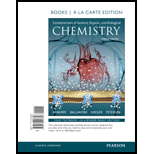
Concept explainers
Interpretation:
The number of balloons which can be filled by the helium gas should be determined if each balloon has a volume of
Concept Introduction:
Different laws have been put forward to introduce properties of gases:
Boyle’s law:
At fixed temperature, the volume of a fixed amount of gas is inversely proportional to the pressure exerted by the gas.
Charles law: States that volume is directly proportional to temperature when the gas is held
at constant pressure and number of molecules.
General
Want to see the full answer?
Check out a sample textbook solution
Chapter 8 Solutions
Modified Masteringchemistry With Pearson Etext -- Valuepack Access Card -- For Fundamentals Of General, Organic, And Biological Chemistry
- How many moles of chlorine gas at 120. °C and 33.3 atm would occupy a vessel of 39.0 L?arrow_forward15.0 L of an ideal gas at 298 K and 3.36 atm are heated to 383 K with a new pressure of 6.05 atm. What is the new volume in liters?arrow_forwardA balloon occupies a volume of 1.25 L at sea level where the ambient pressure is 1 atm. What volume would the balloon occupy at an altitude of 10,700 m, where the air pressure is only 220 mmHg?arrow_forward
- Calculate the mass of a liquid with a density of 3.2 g/mL and a volume of 25 mLarrow_forwardNitric acid can be produced by the reaction ofgaseous nitrogen dioxide with water.3 NO2(g) + H2O(ℓ) −→2 HNO3(ℓ) + NO(g)If 956 L of NO2 gas react with water, whatvolume of NO gas will be produced? Assume the gases are measured under the sameconditionsarrow_forwardHow many kilocalories are needed to vaporize 5.8 mol of Br2?arrow_forward
- If 4.00 L of ethyl alcohol at 18.0 ⁰C is exposed to a temperature of 25.0 ⁰C, what is the resulting volume? (Alcohol: β = 1100x10⁻⁶ / ⁰C) * a. 4.03 L b. 4.31 L c. 0.308 L d. 0.0308 Larrow_forwardIf the value of mass doubles but the volume stays the same, the value for density will bearrow_forwardWhat is the vapor pressure of a liquid?arrow_forward
- Basic Clinical Lab Competencies for Respiratory C...NursingISBN:9781285244662Author:WhitePublisher:Cengage



